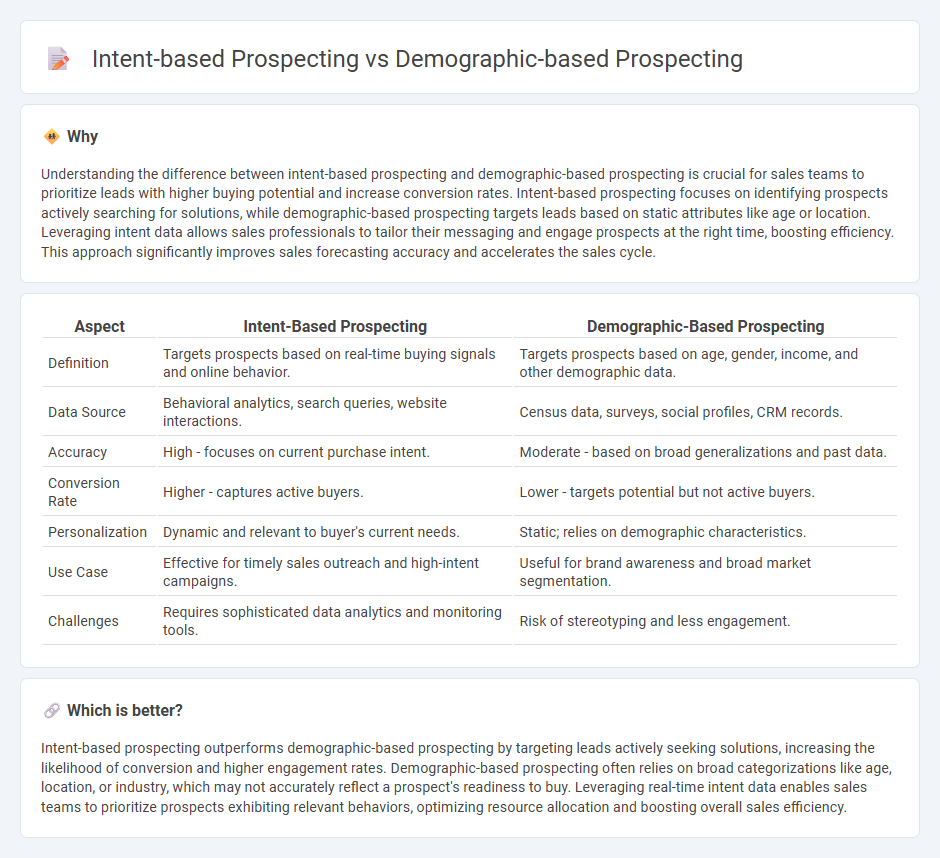
Intent-based prospecting leverages real-time behavioral data and customer signals to identify prospects actively seeking solutions, resulting in higher engagement rates and conversion opportunities compared to traditional demographic-based prospecting, which targets audiences based solely on age, location, or job title. This data-driven approach optimizes sales efforts by focusing resources on leads demonstrating intent, improving efficiency and sales pipeline quality. Explore how shifting to intent-based prospecting can transform your sales strategy and boost revenue growth.
Why it is important
Understanding the difference between intent-based prospecting and demographic-based prospecting is crucial for sales teams to prioritize leads with higher buying potential and increase conversion rates. Intent-based prospecting focuses on identifying prospects actively searching for solutions, while demographic-based prospecting targets leads based on static attributes like age or location. Leveraging intent data allows sales professionals to tailor their messaging and engage prospects at the right time, boosting efficiency. This approach significantly improves sales forecasting accuracy and accelerates the sales cycle.
Comparison Table
| Aspect | Intent-Based Prospecting | Demographic-Based Prospecting |
|---|---|---|
| Definition | Targets prospects based on real-time buying signals and online behavior. | Targets prospects based on age, gender, income, and other demographic data. |
| Data Source | Behavioral analytics, search queries, website interactions. | Census data, surveys, social profiles, CRM records. |
| Accuracy | High - focuses on current purchase intent. | Moderate - based on broad generalizations and past data. |
| Conversion Rate | Higher - captures active buyers. | Lower - targets potential but not active buyers. |
| Personalization | Dynamic and relevant to buyer's current needs. | Static; relies on demographic characteristics. |
| Use Case | Effective for timely sales outreach and high-intent campaigns. | Useful for brand awareness and broad market segmentation. |
| Challenges | Requires sophisticated data analytics and monitoring tools. | Risk of stereotyping and less engagement. |
Which is better?
Intent-based prospecting outperforms demographic-based prospecting by targeting leads actively seeking solutions, increasing the likelihood of conversion and higher engagement rates. Demographic-based prospecting often relies on broad categorizations like age, location, or industry, which may not accurately reflect a prospect's readiness to buy. Leveraging real-time intent data enables sales teams to prioritize prospects exhibiting relevant behaviors, optimizing resource allocation and boosting overall sales efficiency.
Connection
Intent-based prospecting leverages behavioral data to identify prospects actively seeking solutions, while demographic-based prospecting targets specific groups based on characteristics like age, location, and job title. Combining these approaches enhances sales efficiency by focusing outreach on individuals who not only fit the ideal customer profile but also exhibit buying signals. Integrating intent data with demographic filters results in higher conversion rates and more personalized engagement strategies.
Key Terms
Buyer Persona
Demographic-based prospecting targets potential buyers using quantifiable attributes like age, gender, income, and job title, focusing on a general Buyer Persona profile to segment audiences. Intent-based prospecting, however, leverages real-time data such as browsing behavior, search queries, and content engagement to identify prospects actively interested in a product or service, providing a dynamic and precise approach to reaching motivated buyers. Explore deeper insights on optimizing Buyer Persona strategies for enhanced prospecting effectiveness.
Behavioral Signals
Demographic-based prospecting targets audiences using characteristics like age, gender, income, and location, whereas intent-based prospecting leverages behavioral signals such as online search queries, content consumption, and engagement patterns to identify high-potential leads. Behavioral signals offer deeper insights into a prospect's immediate needs and purchase readiness, making intent-based strategies more effective for personalized marketing campaigns and higher conversion rates. Explore how combining demographic data with behavioral intent can optimize your prospecting success.
Lead Scoring
Demographic-based prospecting uses characteristics such as age, location, and job title to score leads, while intent-based prospecting analyzes online behavior and engagement signals to identify purchase readiness. Lead scoring models that integrate both demographic and intent data tend to deliver higher conversion rates by targeting prospects with relevant messaging at optimal times. Explore advanced lead scoring techniques to maximize sales pipeline efficiency and ROI.
Source and External Links
How Customer Prospecting by Demographic Data works--ArcMap - This tool searches geographic areas (e.g., ZIP Codes, census tracts) to find those that match specified demographic criteria such as income, age, and gender, helping businesses identify potential customer locations efficiently.
Customer Demographics: How to Collect and Use - Drive Research - Demographic-based prospecting segments consumers by age, gender, income, and location, enabling businesses to tailor pricing, promotions, and marketing efforts to local and group-specific needs.
Demographic Segmentation Overview | Experian Marketing - By grouping consumers based on shared characteristics like age, gender, income, and family status, demographic segmentation allows businesses to deliver more relevant marketing messages and optimize resource allocation.
 dowidth.com
dowidth.com